
The Abbey of Saint Gall is a dissolved abbey (747–1805) in a Catholic religious complex in the city of St. Gallen in Switzerland. The Carolingian-era monastery has existed since 719 and became an independent principality between 9th and 13th centuries, and was for many centuries one of the chief Benedictine abbeys in Europe. It was founded by Saint Othmar on the spot where Saint Gall had erected his hermitage. The library of the Abbey is one of the richest medieval libraries in the world. The city of St. Gallen originated as an adjoining settlement of the abbey. Following the secularization of the abbey around 1800 the former Abbey church became a Cathedral in 1848. Since 1983 the whole remaining abbey precinct has been a UNESCO World Heritage Site.
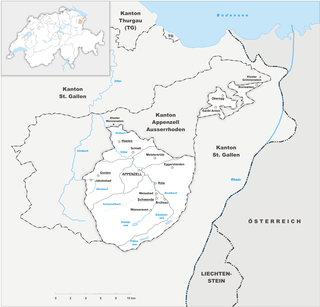
The canton of Appenzell Innerrhoden is the smallest canton of Switzerland by population and the second smallest by area, with canton of Basel-City being the smallest. It was the last Swiss canton to grant women the right to vote on local issues, in 1991.

The canton of Appenzell Ausserrhoden is a canton of Switzerland. The seat of the government and parliament is Herisau, judicial authorities are in Trogen. Appenzell Ausserrhoden is located in the north east of Switzerland, bordering the cantons of St. Gallen and Appenzell Innerrhoden.
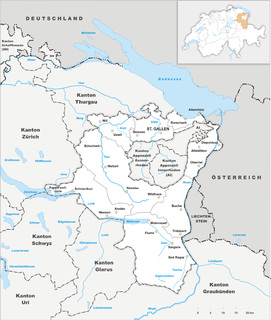
The canton of St. Gallen, also canton of St Gall, is a canton of Switzerland. The capital is St. Gallen.
Appenzell is a historic canton in the northeast of Switzerland, and entirely surrounded by the canton of St. Gallen.

Rorschach is a municipality, in the District of Rorschach in the canton of St. Gallen in Switzerland. It is on the south side of Lake Constance (Bodensee).
The Appenzell Wars were a series of conflicts that lasted from 1401 until 1429 in the Appenzell region of Switzerland. The wars were a successful uprising of cooperative groups, such as the farmers of Appenzell or the craftsmen of the city of St. Gallen, against the traditional medieval power structure represented by the House of Habsburg and the Prince-Abbot of the Abbey of St. Gall.

Clanx Castle is a ruined castle in the Appenzell District of the canton of Appenzell Innerrhoden in Switzerland.

Hagenwil Castle is a castle in the municipality of Amriswil of the Canton of Thurgau in Switzerland. It is a Swiss heritage site of national significance. It is the only remaining intact water castle in eastern Switzerland.

Pfäffikon Castle is a castle in the municipality of Freienbach of the Canton of Schwyz in Switzerland. It is a Swiss heritage site of national significance.
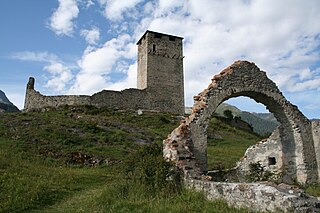
Steinsberg Castle is a ruined castle in the former municipality of Ardez of the Canton of Graubünden in Switzerland. It is a Swiss heritage site of national significance.

Jörgenberg Castle is a castle in the municipality of Waltensburg/Vuorz of the Canton of Graubünden in Switzerland. It is a Swiss heritage site of national significance.

Rosenburg Castle is a ruined castle located to the west of the municipality of Herisau in the canton of Appenzell Ausserrhoden in Switzerland. It is a Swiss heritage site of national significance. The castle is on the Ramsenstock and is therefore also called Ramsenburg.

Rudenz Castle is a ruined castle atop a hill in the municipality of Giswil in the canton of Obwalden in Switzerland. The castle and surroundings are a Swiss heritage site of national significance.
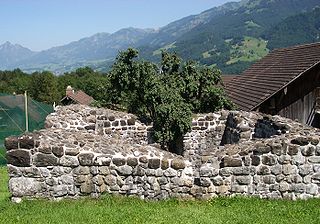
Rosenberg Castle is a ruined castle in the municipality of Giswil in the canton of Obwalden in Switzerland.

Cagliatscha Castle German: Burg Cagliatscha is a ruined castle in the municipality of Andeer in the Viamala Region of the canton of Graubünden in Switzerland.

Canaschal Castle is a pair of ruined castles near Trin, Canton of Graubünden, Switzerland.

Castelberg Castle is a ruined castle in the municipality of Ilanz/Glion of the Canton of Graubünden in Switzerland.
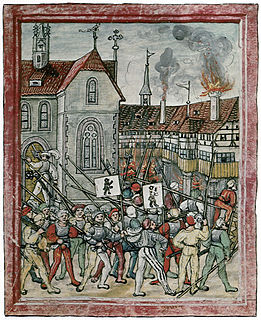
The Rorschacher Klosterbruch or St. Gallerkrieg was a war between the Abbey of Saint Gall, Zürich, Lucerne, Schwyz and Glarus against the city of St. Gallen and Appenzell in 1489 to 1490.

Franz von Gaisberg was librarian from 1491 to ca. 1496 and abbot of the Abbey of Saint Gall from 1504 to 1529.




















